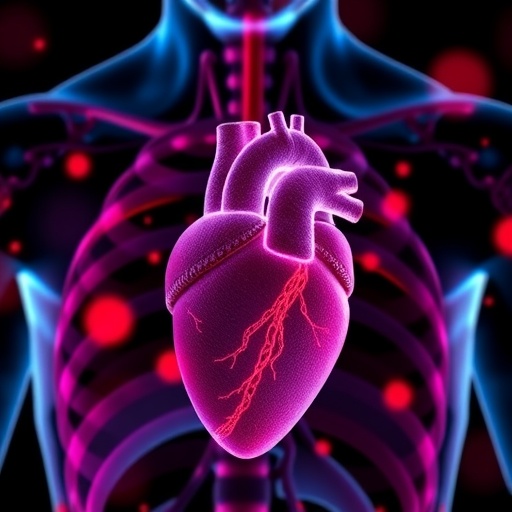In the rapidly evolving field of cardiovascular medicine, the accurate and timely diagnosis of acute myocardial infarction (AMI) remains one of the most critical challenges. Traditional diagnostic approaches, while effective in many cases, occasionally fall short in providing the specificity and sensitivity required for early and differential diagnosis, especially in complex clinical scenarios. A groundbreaking study led by Zhou, P., Zhang, J., and Wu, X., published in the International Journal of Legal Medicine in 2025, now offers a promising new avenue: the use of plasma exosomal microRNA as a powerful biomarker for distinguishing AMI from other cardiac events and conditions.
At the heart of this innovative diagnostic strategy is the tiny yet potent biological package known as the exosome. These nano-sized vesicles are secreted by cells into bodily fluids, serving as carriers for an array of molecular messengers, including microRNAs (miRNAs). Unlike free-circulating molecules that can degrade quickly or be influenced by systemic factors, exosomal miRNAs are remarkably stable and protected, making them ideal candidates for precise biomarker development. Zhou and colleagues have harnessed this unique stability to probe the plasma exosomal miRNA profiles associated with acute myocardial infarction, aiming to refine diagnostic accuracy significantly.
The study’s methodology involved isolating plasma exosomes from patients presenting with symptoms indicative of AMI as well as from control groups suffering from other cardiac-related conditions such as unstable angina and certain inflammatory heart diseases. Using high-throughput sequencing technologies, the researchers identified distinct microRNA signatures embedded within the exosomes that correlated strongly with the presence of myocardial infarction. These molecular fingerprints were then cross-validated through advanced quantitative PCR methods to confirm their diagnostic value.
.adsslot_FqvPyndYBz{ width:728px !important; height:90px !important; }
@media (max-width:1199px) { .adsslot_FqvPyndYBz{ width:468px !important; height:60px !important; } }
@media (max-width:767px) { .adsslot_FqvPyndYBz{ width:320px !important; height:50px !important; } }
ADVERTISEMENT
One of the most striking findings was the identification of specific miRNAs that were consistently upregulated in AMI patients compared to controls. These included miR-208a, miR-499, and several novel microRNAs that had not previously been associated with cardiac injury but showed remarkable specificity for myocardial damage when packaged in exosomes. This specificity opens the door not only for differentiating AMI from other acute coronary syndromes but also for understanding the pathophysiological nuances that distinguish different types of cardiac injury at a molecular level.
The implications of this research transcend diagnostic accuracy. The authors envision that profiling exosomal miRNAs could also contribute to prognostic assessments, enabling clinicians to stratify patients based on the risk and severity of myocardial injury. Additionally, this approach could guide therapeutic decisions, tailoring interventions to individual molecular profiles and improving outcomes in a highly personalized medicine framework.
Technically, the study employed meticulous protocols for exosome isolation, including ultracentrifugation combined with size-exclusion chromatography, ensuring high purity and yield necessary for reproducible miRNA analysis. The subsequent application of next-generation sequencing provided a comprehensive view of the exosomal miRNA transcriptome, while rigorous bioinformatics analyses deciphered the complex expression patterns and identified candidate biomarkers with statistical robustness. This combination of sophisticated molecular techniques underscores the study’s thoroughness and sets a new standard for biomarker research.
Intriguingly, the research also hinted at the biological role these miRNAs might play beyond their diagnostic value. Many of the microRNAs packaged in exosomes during AMI are known to regulate apoptosis, inflammation, and tissue remodeling—processes central to myocardial injury and repair. This suggests that exosomal microRNAs not only reflect cardiac pathology but may actively participate in intercellular communication during disease progression, representing potential therapeutic targets themselves.
From a broader perspective, this study exemplifies the increasing convergence of molecular biology, nanotechnology, and clinical cardiology to forge novel diagnostic paradigms. The use of exosomal contents as a diagnostic reservoir is a frontier area with vast potential, extending beyond cardiovascular diseases to oncology, neurology, and autoimmune disorders. Zhou et al.’s findings contribute a crucial piece to this expanding puzzle, demonstrating clinical feasibility and laying groundwork for future translational studies.
Challenges remain, however, before exosomal miRNA diagnostics can enter routine clinical practice. Standardization of exosome isolation protocols, normalization of miRNA expression data, and large-scale validation across diverse populations are necessary steps. Moreover, cost-effectiveness and integration into current diagnostic workflows will require further assessment. Nonetheless, the momentum generated by this study invigorates ongoing efforts and will likely accelerate regulatory and clinical adoption.
The legal and forensic implications of accurate, rapid AMI diagnosis using plasma exosomal miRNAs should not be underestimated either. In forensic medicine, distinguishing myocardial infarction from other causes of sudden death can be challenging, particularly in post-mortem contexts. The stability of exosomal miRNAs in plasma preserved post-mortem offers a new molecular tool for legal investigations, potentially aiding in cause-of-death determinations with unprecedented precision.
In conclusion, the pioneering work by Zhou, P., Zhang, J., Wu, X., and collaborators marks a significant advancement in cardiovascular diagnostics. By focusing on plasma exosomal microRNAs as a differential diagnostic tool for acute myocardial infarction, this research not only enhances clinical decision-making but also opens new horizons for understanding the molecular dynamics of heart disease. As the science of exosomes matures, this approach may well transform how clinicians detect, monitor, and treat myocardial infarction, ultimately saving lives and improving the quality of cardiac care.
Subject of Research:
Article Title:
Article References:
Zhou, P., Zhang, J., Wu, X. et al. Differential diagnosis of acute myocardial infarction based on plasma Exosomal MicroRNA.
Int J Legal Med (2025). https://doi.org/10.1007/s00414-025-03583-2
Image Credits: AI Generated
DOI: 10.1007/s00414-025-03583-2
Keywords: Acute myocardial infarction, Plasma exosomes, microRNA, Biomarkers, Diagnostic methods, Cardiovascular disease, Nanovesicles, Molecular diagnostics
Tags: acute myocardial infarction diagnosticsbiomarkers for heart attacksCardiovascular medicine innovationsdiagnosing acute myocardial infarctiondistinguishing AMI from other conditionsexosomal vesicles in diagnosisexosome-based biomarkersmicroRNA stability in bloodplasma exosomal microRNAprecision medicine in cardiologytraditional vs novel diagnostic methodsZhou et al. 2025 study





